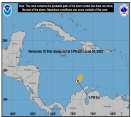cieldumort
Moderator

Reged:
Posts: 2519
Loc: Austin, Tx
|
 Feature To Watch: Central Atlantic Low Getting Much More Organized
Feature To Watch: Central Atlantic Low Getting Much More Organized
Fri Oct 22 2010 02:43 AM Attachment (283 downloads)
|
|
|
A low pressure system in the central Atlantic that has been heading west for several days with intermittent bursts of convection, mostly to the northeast of the center, has been improving markedly in structure during the day Thursday, and now into the overnight. While the NHC still lists this feature as a 10% chance of becoming a tropical cyclone within the next 48 hours, this looks to be almost wildly conservative. Depending on the analysis, this yet-to-be-Invest-tagged feature already has many hallmarks of a tropical depression - perhaps even better.
Based on
Night Vision IR , the most prominent LLC associated with this feature looks to be located just west of the deepest convection, as of this post, roughly near 13.5N and 42.5W. (Also see attached recent ASCAT pass with a fairly tight surface circulation clearly identifiable near that location, with winds in the 25-30 knot range).
Convection is stretched SW-NE, but the tight inner LLC does not appear to be. Using a sheared pattern Dvorak technique yields about a 2.0 to 2.5 CI, handily. It will be very interesting to see what daylight may show. Also, this cyclone is approaching a reliable buoy, Station 41041, which already seems to be reacting to its approach, with increasing northeasterly winds, and generally lowering surface pressure.
To be sure, this system is currently noted in the TWO, as follows:
Quote:
2. A LARGE OF SHOWERS AND THUNDERSTORMS ASSOCIATED WITH A LOW
PRESSURE SYSTEM IS CENTERED ABOUT 1150 MILES EAST OF THE LESSER
ANTILLES. STRONG UPPER-LEVEL WINDS ARE FORECAST TO INHIBIT THE
DEVELOPMENT OF THIS DISTURBANCE...AND THERE IS A LOW CHANCE...10
PERCENT...OF THIS SYSTEM BECOMING A TROPICAL CYCLONE AS IT MOVES
SLOWLY WESTWARD DURING THE NEXT 48 HOURS.
IMHO, this statement does not capture the vitality of this feature, and seems a bit obsolete. While indeed perhaps upper level winds may very well inhibit much more development, it has not yet inhibited sufficient development to be worthy of, say, an Invest tag, to say the least.
While this feature is still out in the central Atlantic with many days before any chance of interaction with land, my interest is not purely academic. Speaking candidly, the 2010 season has the potential to surprise on the upside not only for the remainder of this week, but for the remainder of this year.
Climatology may warrant low-balling features floating about the central or eastern Atlantic this late in a year, but not during very active seasons. Not this year.
|
|




 Flat
Flat



